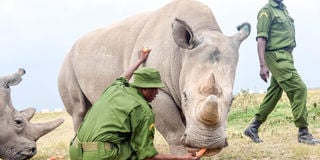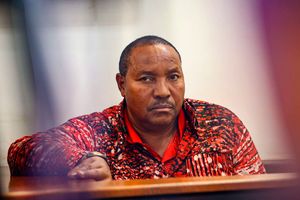Premium
Orphaned rhinos find safe refuge in South Africa sanctuary

A caretaker feeds 19-year-old Fatu, one of the world’s last two Northern White Rhinos in Ol Pejeta Conservancy. Kenya is home to the last remaining two Northern White Rhinos in the world.
What you need to know:
- Most of the calves have been orphaned by poachers.
- Rhinos are killed for their horns, highly priced across Asia for traditional and medicinal purposes.
- One kilogram of the keratin, obtained from their horns, can sell for over $110,000 (90,000 euros) on the black market.
Rhinoceros calf "Jessie" was just four-months-old when she arrived at a shelter in northern South Africa, bleeding from a cut to the shoulder and deeply traumatised. Rescuers suspect the animal was injured by poachers who took out its mother, hitting the calf with a machete to keep it away. Jessie was lucky to escape alive and land in a unique centre devoted to rehabilitating rhino orphans. "It took two days of giving her Valium for her to calm down," carer Zanre Van Jaarsveld recalled. "She was very dehydrated too."
Security and vigilance
The Rhino Orphanage is tucked away in the lush forests of South Africa's Limpopo province, hidden at the end of a red-dirt track dotted with potholes. Mischievous monkeys dart across the road as a tower of giraffe gallop away elegantly in the distance.
A large metal gate guards the entrance to the centre -- surrounded by several dozen game reserves at an undisclosed location. "If farm workers give information to poachers...they will make more money than they would make in a year's wages," said founder Arrie Van Deventer. Security and vigilance are therefore key to protecting the orphanage, which survives on private donations.
We're their mothers
Van Deventer, a former history teacher turned game breeder, started the project after he was called to help with a poaching incident in 2011.Two white rhino females had been found dead in the area, presumably killed for their horns. One of their two calves was still alive and needed a new home. Van Deventer, 67, made several enquiries to no avail. The only options for the traumatised calf, he said, were tourist facilities where it would be pestered by visitors.
"I found out there was nothing, nowhere ethical," Van Deventer recalled. "Then I heard myself saying over the phone: I'll build one." Today the orphanage is home to a number of rhino calves. Most are of the square-lipped species, also known as white rhino, but some of the rarer critically endangered black rhino are also housed there.The mission is clear: rescue, rehabilitation and release. No tourists allowed, very few visitors and minimal human contact.
Security reasons
"If they get too accustomed to people it makes it more difficult to release them into the wild," Van Deventer explained, adding that the grounds were also closed to the public for "security reasons". Four staff and two volunteers, all women, work around the clock to nurse the rhinos, sometimes even sleeping next to the youngest calves in an open faced barn.
"We're their mothers," said manager Yolande Van Der Merwe, 38. "They sleep very close for warmth and comfort. "Someone brings (us) food, or if we want to take dinner or a bathroom break someone comes to stay with them," she told AFP. "As soon as they are left alone they start screaming. "Their cries are high-pitched, something like the sound of a dolphin, according to Van Deventer.
Voracious orphans
Most of the calves have been orphaned by poachers. Rhinos are killed for their horns, highly priced across Asia for traditional and medicinal purposes. One kilogram of the keratin, obtained from their horns, can sell for over $110,000 (90,000 euros) on the black market. The trade is lucrative and thousands of rhinos have been poached in South Africa over the past decade as a result.
At the orphanage, the three youngest residents -- two females and a male -- impatiently wait for large baby bottles brimming with a mix of milk and boiled rice. Rhinos gain over 350 kilograms in their first year of life and calves need to feed every few hours. "At five or seven days old they are tiny, knee-high," gestured Van Der Merwe. "They gain a kilo a day at least."
By their first birthday, rhinos generally weigh close to half a tonne. As the calves grow restless, Van Jaarsveld, 26, affectionately scratches their thick leathery skin. "It's close to milk, now they are getting cranky," she chuckled. Among them is Jessie, still skittish eight months after her rescue. "She's very jumpy," said Van Jaarsveld. "She gets frightened very easily."
Calves stay at the orphanage until the age of five, when they are deemed strong enough to defend themselves from predators. They are then released in a nearby game reserve where a conservationist keeps the orphanage updated on their progress.





